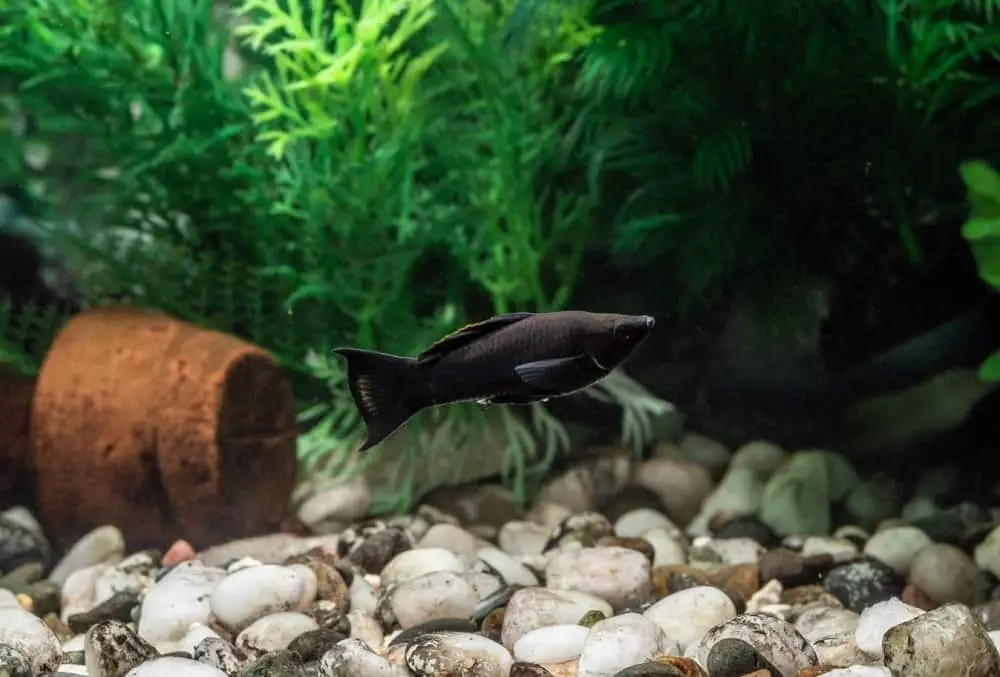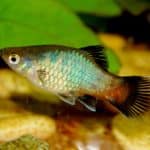The Black Molly is one of the most popular aquarium fish in the world. What makes this fish so appealing for most people is their jet-black appearance, which is where their name comes from.
They’re also a great addition to community tanks, they’re hardy, and they are easy to keep. These things make them an excellent choice for any novice aquarium owner.

However, if you’ve been thinking about introducing a Black Molly into your tanks, there are a few important things you need to know first. Below, you’ll find the ultimate Black Molly care guide.
We’ll talk you through tank size, what other fish they can live with, common diseases, and everything else you could ever need to know about the Black Molly.
Species Summary
Let’s start by taking a look at Black Mollies as a species. They are a smaller species of fish that belong to the Poecilia sphenops family. They are also a live-bearing fish, and this basically means that they don’t lay eggs to produce their offspring.
Black Mollies are native to Central America, however, they can also be found in other parts of the world including Mexico, Venezuela, and several Caribbean islands. It is quite rare to find a Black Molly in the wild though, as their unique coloring is mostly due to captive breeding.
Those that do live in the wild mostly reside in freshwater streams, but they’ve also been known to survive in swamps and brackish waters. The ability to live in these water quality fluctuations is what makes them one of the hardiest aquarium fish out there.
Care Guide
Tank Size
Black Mollies are active fish and, as such, they need a lot of room to move around in. With this in mind, the minimum tank size you need to provide a Black Molly with is 20-gallons. If you want to keep more than one Black Molly, you’ll need to provide an extra 5-gallons of space for each additional fish.
This is something that’s incredibly important to note when you’re creating a community tank. Overcrowding can lead to aggressive behavior, even between the most docile of species. It can also dramatically impact your fish’s health and, as such, reduce their lifespan.
Tank Mates
Black Mollies are an excellent addition to a community aquarium and, as long as each fish is given enough space, they’ll live in perfect harmony with a huge variety of tank mates. The best fish for pairing with Black Mollies include:
- Guppies
- Danios
- Tetras
- Gouramis
- Platies
- Female Betta Fish
- Swordtail Fish
- Cherry Barbs
- Rosy Barbs
- Tiger Barbs
- Harlequin Rasbora
- Corydoras Catfish
- Zebra Loaches
- Yo-Yo Loaches
- Invertebrates
Same Species Tanks
As well as living quite happily with several other species of fish, Black Mollies can be paired with other types of Molly. However, as always, it’s incredibly important to make sure that the first fish has 20-gallons of space, and each additional Molly you add to the tank has an extra 5-gallons.
Different types of Mollies that you can create a same species tank with alongside Black Mollies include:
- Dalmatian Mollies
- Dalmatian Lyretail Mollies
- White Sailfin Mollies
- Silver Sailfin Mollies
- Gold Dust Mollies
- Balloon Belly Mollies
- Marble Lyretail Mollies
- Gold Doubloon Mollies
- Harlequin Sailfin Mollies
- Platinum Lyretail Mollies
- Golden Sailfin Mollies
- Creamsicle Sailfin Lyretail Mollies
- Red Sunset Mollies
Water Parameters
While Black Mollies are hardy fish that can withstand water temperature and quality fluctuations, it is best to keep within certain water parameters if you want to offer them the best quality of life. Here’s what you should aim for:
- Water Temperature: 70-80ºF (21º-26ºC)
- Alkaline pH Level: 7.0 – 8.5
- Water Hardness: 20.0 – 35.0 dH
What To Put In Their Tank
As well as making sure your tank is the right size and the water parameters are perfect, you’ll need to include some important accessories to make your Black Molly feel at home.
The first of these is a few aquarium plants. These offer both shelter and sustenance for Black Mollies, as they’ll be able to hide when they feel threatened and feed on any algae that accumulate on them. Black Mollies also rely on aquarium plants for breeding, as their young are able to hide amongst the leaves.
Some of the best aquarium plants for Black Mollies include:
- Water Wisteria
- Java Moss
- Water Sprite
- Java Fern
- Anubias
- Hygrophila
You also need to provide a secondary place of shelter for your Black Mollies to swim to when they feel threatened. This could be a piece of driftwood or a cave-like ornament.
You also need to provide a sandy substrate and a source of artificial light. These are actually more beneficial to the plants in your aquarium but, in a circle of life fashion, healthy plants mean healthy fish!
Common Diseases
While Black Mollies are fairly hardy fish, there are some species-specific diseases that they may develop throughout their lifetime.
The first of these is the aptly named “Molly Disease”. This is usually a result of poor living conditions such as space and incorrect water parameters. Symptoms include less activity and swimming on the spot. Luckily, this is easily treated by improving the conditions inside your tank.
Black Mollies can also suffer from fin rot. This is a bacterial infection that is most common in fish that are stressed. It’s especially common in Black Mollies that are paired with larger, more aggressive fish.
Symptoms include fraying fins and tails. This can be treated with quarantine and a course of veterinarian-prescribed antibiotics.
Food & Diet
Black Mollies are omnivorous fish and, as such, they have a pretty varied diet in the wild. However, when kept in captivity, they are only able to eat what becomes available to them. So, it’s important to make sure that you’re feeding your Black Molly a wide variety of food.
A good-quality fish food should be given every day, but you can also supplement this with invertebrates such as brine shrimp, daphnia, and micro-worms. They’ll also enjoy feeding on algae, which should naturally accumulate on your aquatic plants.
You should also give them a weekly serving of fresh vegetables such as cucumbers, zucchini, and peas. Just remember to remove any uneaten vegetables from the tank within 24 hours, otherwise, the water parameters could become compromised.
Lifespan
The average lifespan of a Black Molly is between 3-5 years. However, this mostly depends on the living conditions and the diet that the fish has been given. Well-cared-for Black Mollies have a much higher life expectancy than those living in overcrowded tanks and feed only on fish flakes.
Appearance
Black Mollies take their name from their appearance, and they are entirely black in color. The reason for this is because they have been captively bred to be born with melanism, which is the opposite of albinism.
There are occasions when Black Mollies are born with a yellow stripe running vertically across their dorsal fin, or with a slightly silver color on their flanks. However, this is quite rare and, in almost all instances, Black Mollies are completely black and unmarked.
Size
Black Mollies are relatively small fish and, depending on their sex (females being larger than males) they can grow between 3-5 inches. However, despite being so small, they are an active fish so they need a lot of space to live in.
Behavior & Temperament
Black Mollies are renowned for their peaceful nature, which is why they make such a popular fish for community tanks. However, as with all species of fish, they can develop aggressive behavior if they aren’t given the correct living conditions.
This is mostly due to space, and two male Black Mollies will become territorial if they aren’t given at least 5-gallons of space each. But, as long as each has enough room to swim freely, aggression shouldn’t be an issue.
Breeding
The first thing to note when it comes to breeding is that Black Mollies are live-bearing fish. This means that they don’t go through an egg-laying process. Instead, they simply birth their young as small, ready-formed fish.
However, it is always a good idea to isolate a pregnant Black Molly in her own tank. And, once the fry have been born, you should isolate the mother in another tank.
The reason for doing this is to keep the young safe from any other fish in your main aquarium who could mistake them for food. The mother fish may also try to eat the live young!
The gestation period will take around 6-8 weeks and, once complete, a female Black Molly can give birth to as many as 40-100 fry at once!
Gender Differences: Male VS. Female
The easiest way to identify the difference between male and female Black Mollies is to look at the triangular fin located near the anus. If there is a dark, swollen point, you have a female Black Molly. If there isn’t, it’s a male.
Fun Facts
- Black Mollies are one of the fastest aquarium fish on the planet.
- Black Mollies are not natural parents. When they give birth to their live young, they will try and eat them!








